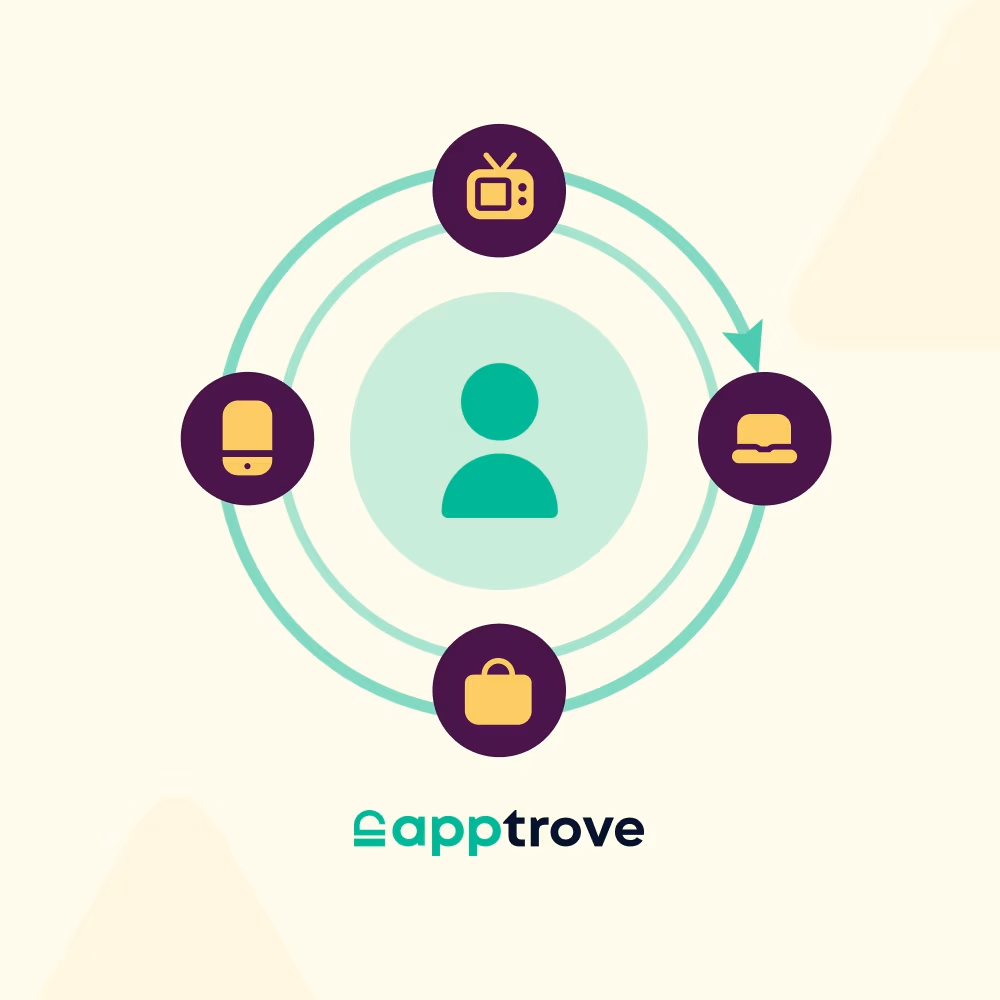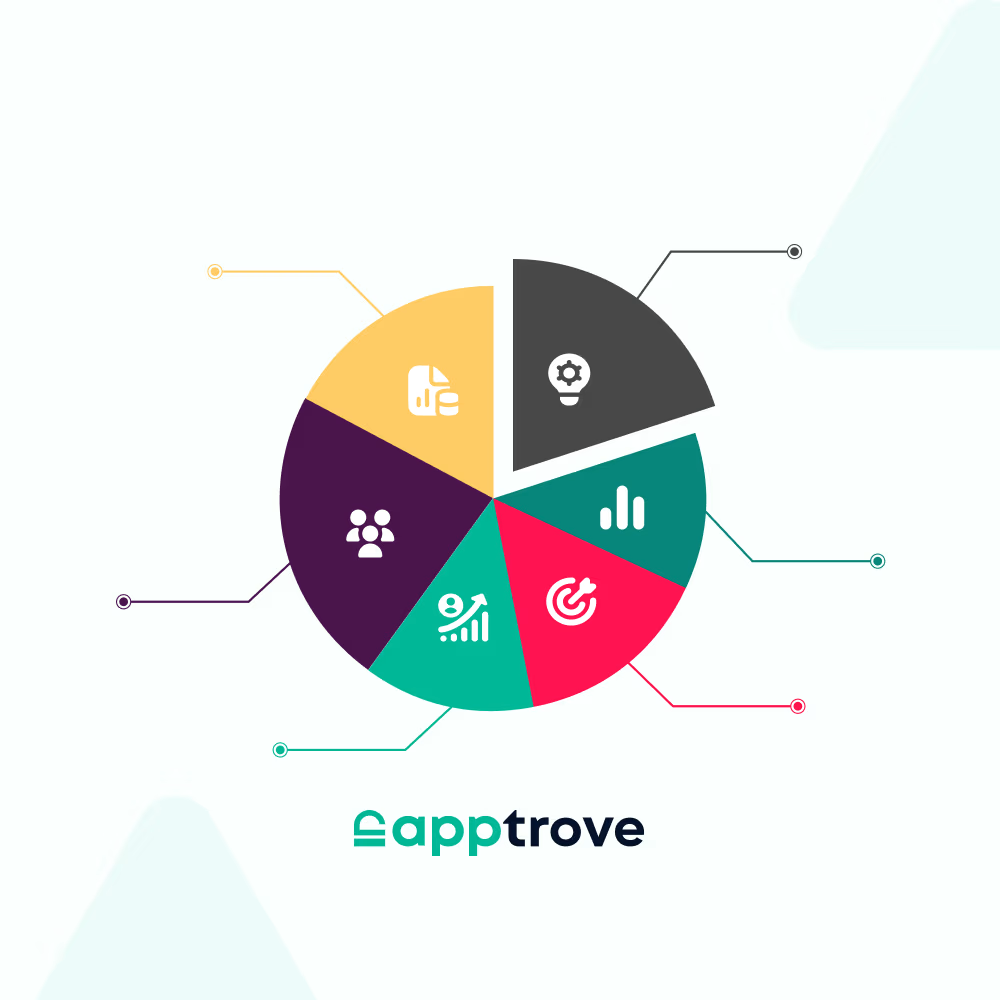Your marketing dashboard is juicy. Installs are high, and clicks are in, and your campaigns appear to be doing good. To the naked eye, all is good. But under the measures and pageantry in the press releases is an undercurrent that most marketers studiously avoid: Did that user convert because of your ad or would have they converted anyway?
That is one question that clears all the noise about performance marketing. And the answer lies in a single concept: incrementality.
Incrementality is the marketing metric that strips away vanity, exposes what’s truly working, and helps you make smarter decisions with your budget. While most traditional KPIs, like cost per install (CPI), clickthrough rates (CTR), or even ROAS – tell you what happened. Incrementality tells you why it happened, and more importantly, whether your actions made any real difference at all. It is particularly important in a privacy-conscious and signal limited mobile environment today. It is increasingly difficult to attribute to each channel and over 80% of marketers are finding it difficult to accurately measure ROI per channel. User journeys are more complicated. And marketers cannot afford to spend money on media which appears good on paper but actually does not give any lift.
In this comprehensive guide, we’ll dive deep into the world of incrementality and uncover how it reshapes the way you evaluate success. You’ll learn what incrementality really means, how it differs from traditional attribution models, and why it’s become the gold standard for measuring real marketing effectiveness. We’ll also walk through how to design your own incrementality tests, spot meaningful lift, and use tools like Apptrove’s real-time fee analysis dashboard to uncover insights that surface-level metrics can’t. By the end of this read, you’ll have the clarity, confidence, and frameworks to make incrementality your north star metric, not just another line on a report.
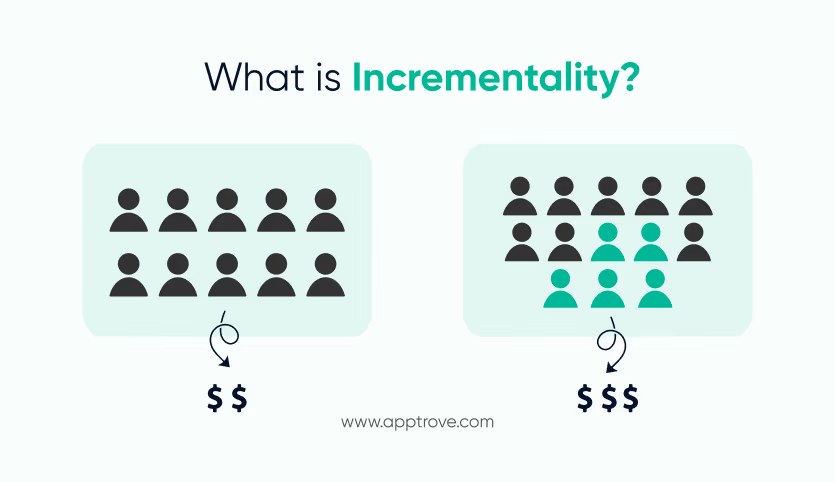
What is Incrementality? Understanding the Core Metric for Real Growth
At its most foundational level, incrementality is the measure of causality in marketing. It is a variance between the correlation and real impact the differences between what occurred and what was actually the result of your marketing efforts. Rather than asking “Which channel touched the user last?” as traditional attribution models do, incrementality asks the more meaningful and difficult question:
“Had the user not encountered the ad, would have she still done the same thing?” Such a proportion as 83% of resulting conversions is likely to be the attributions occurred regardless. Your campaign might be exaggerating the true worth. This underscores the importance of focusing on incremental lift, the 17% that represents true net‑new impact.
The implication of this slight repackaging is enormous. And should the response be then yes ? that is, the user would have installed the application, bought the thing, enrolled in the service, whether or not your ad was seen ? then the campaign did not add any value; it simply appropriated credit. However, in case of a no, in case the ad was the catalyst, and moved the user to act, then that activity will be incremental, and your campaign can claim to have had a real impact.
Understanding incrementality reshapes how marketers think about performance, efficacy, and optimization. It does away with the urge to overemphasise vanity metrics and makes a more intrusive inquiry into what is actually effective. Although the other common KPIs, such as cost per install (CPI), clickthrough rate (CTR), or return on ad spend (ROAS) give information about surface activity, they do seldom tell the causes behind the behavior. Such indicators tend to be descriptive and not diagnostic. Incrementality flips this on its head by focusing entirely on the why, not just the what.
The key to measuring incrementality lies in establishing a true counterfactual; that is, creating a control condition that allows you to isolate the effect of your marketing activity. This normally occurs through well crafted experiments: such as placing your audience into 2 statistically comparable groups- through directing a group of people to see your ad campaign, and through letting a different group of people not see your ad campaign. You then follow both groups over time and compare the results in terms of conversion, revenue, engagement or retention.
If there is a statistically significant difference in outcomes between the two groups, that difference is considered the incremental lift. And that is the actual attribute to measure of your promotional work.
Why Incrementality Is the Only Reliable Metric in a Privacy-First, Post-IDFA World
Incrementality also brings a much-needed layer of rigor to mobile marketing, particularly in the post-privacy, post-IDFA era, where user-level data is fragmented, and deterministic tracking is no longer reliable. With platforms like iOS severely limiting access to behavioral signals, incrementality offers a privacy-resilient methodology for understanding effectiveness, one that doesn’t rely on deterministic attribution paths or fingerprinting techniques, but instead on sound experimental design and data-driven analysis.
In addition, this idea is not isolated to paid acquisition only. It may be used throughout the funnel: including in awareness campaigns, all the way through brand lift studies, creative optimization, price tests, and re-engagement programs. Wherever you can define a control group and track outcomes, incrementality can be tested.
What makes incrementality so powerful is that it introduces accountability to marketing. It puts the marketers through the uncomfortable fact that not all the ad dollars spent result in net-new value. It promotes smarter allocation, perpetual learning, and more disciplined own measurement systems. It dumps guesswork, and shallow performance for evidence and demonstrable business impact.
In today’s fragmented, multi-channel ecosystem, where attribution is often clouded, journeys are non-linear, and privacy regulations limit visibility, incrementality is emerging as the most truthful, actionable, and essential metric for mobile marketers serious about growth.
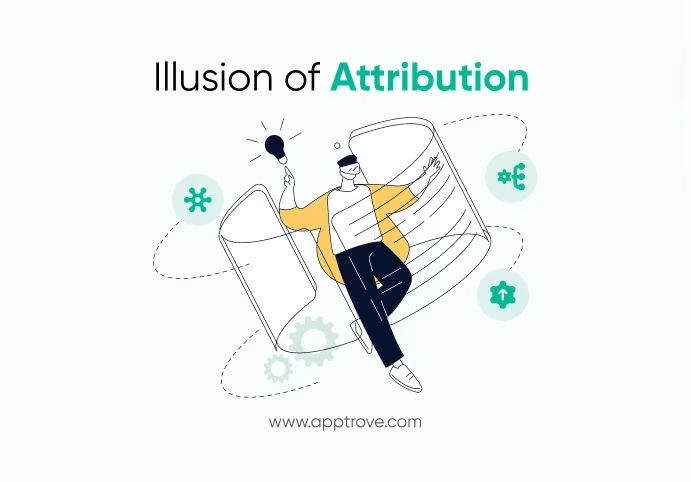
The Illusion of Attribution Without Impact
Contemporary digital marketing infrastructure is developed by having attribution as its cornerstone, so rightfully so. Attribution will showcase the steps being followed by users prior to converting and this way marketers will know where to place budgets and which touchpoints seem to be working best. However, as much as attribution is being used as the literal finish line in the analysis of performance, it is a more complex, and at times, highly misleading issue.
At its best, attribution is a pointing finger as opposed to a causal demonstration. It will be able to inform you about the source of users. It is able to inform you about the activities that led to a conversion. However, what it will not, nor could have possibly been expected to–do is inform you whether the touchpoints were the reason.
This difference is fatal. No, attribution is by its nature backward-looking; attributing credit to channels, creatives, and campaigns. It tracks down the question, what was the advertisement seen by the user before conversion? However, it fails to reveal the much more relevant question, which is, “Did the user convert in any case even without first seeing the ad?”
Suppose that it happens like this: A user views a Facebook advertisement and then within a few minutes downloads your app. Facebook is being given credit by your attribution platform where we can see a successful interaction that would seem to have happened. But peel back another layer, what if that consumer has already heard about your app via word of mouth, what if they have already typed your brand name into the App Store seconds before the ad served? When this is the case, the advertisement did not influence behavior. It simply cut across an already established intention and took the victory.
Credit would still make that install a a campaign success. Incrementality would not.
In fact, rigorous analyses show that true incrementality often falls in the 0–25% range, meaning 75–100% of conversions credited by attribution platforms may not be genuinely incremental. What this implies is that a lot of what appears to be performance, is in fact more organic or expected behavior and is not necessarily ad-driven lift.

Such misattribution, such illusion of performance, provokes a chain reaction of incorrect strategies that might impair even the most data-driven teams of marketers. So let us unpack its three most dangerous risks:
1. Overinvestment in Low-Lift Campaigns
Inaccurate counting as carried out via attribution can result in marketers ascribing conversions that would have naturally taken place in the absence of the campaign or channel to the campaign or channel in question, and therefore of their understanding that the given campaigns or channels are performing highly when the truth is that they might be adding little to no value. Budgets are then redirected to these performing assets they refer to as top performing assets and this creates a misguided circle and eventually bloats the cost of acquiring customers without creating any real growth.
2. Underinvestment in Undervalued Channels
At the other end, attribution is usually given to channels user behavior which affects the user in the upper part of the funnel or indirectly exposed. Consider the upper-funnel awareness activities, partnered with the influencers or brand storytelling. These activities will not necessarily achieve instant conversions but they are instrumental in stimulating the demand that is subsequently achieved by lower-funnel campaigns. Without incrementality testing, these channels appear ineffective on dashboards and are often unjustly defunded.
3. Misleading Performance Metrics (ROAS, CAC)
Attribution may over-report on return on ad spend (ROAS) and misrepresent customer acquisition cost (CAC) by giving conversions that were not causally attributed to paid media. In the situation where marketing reports appear good yet are based on false logic of attribution, decision-makers are likely to spend money on strategies that do not work and scale campaigns that do not generate any lift. This, in the long run, destroys marketing effectiveness, misinforms stakeholders, and even integrity of the brand.
The contemporary formulation of the attribution model depicts a rather incomplete and even misleading picture of the performance. It gives what, and not why. It implies a causation in terms of closeness and not influence. And as it does, it causes marketers to gloat over the mirage of victories even as they float over real opportunities at hand.
Only by incorporating incrementality testing can teams move beyond this illusion to separate apparent performance from actual influence, and make decisions based on evidence, not assumption.
Incrementalism and Incremental Analysis: Small Changes, Big Insights
To operationalize incrementality within a modern marketing framework, it’s essential to understand two foundational principles: incrementalism and incremental analysis. Though they are conventionally applied interchangeably, these terms designate two rather specific, but highly complementary elements of evidence-based and experimentation-powered growth strategy.
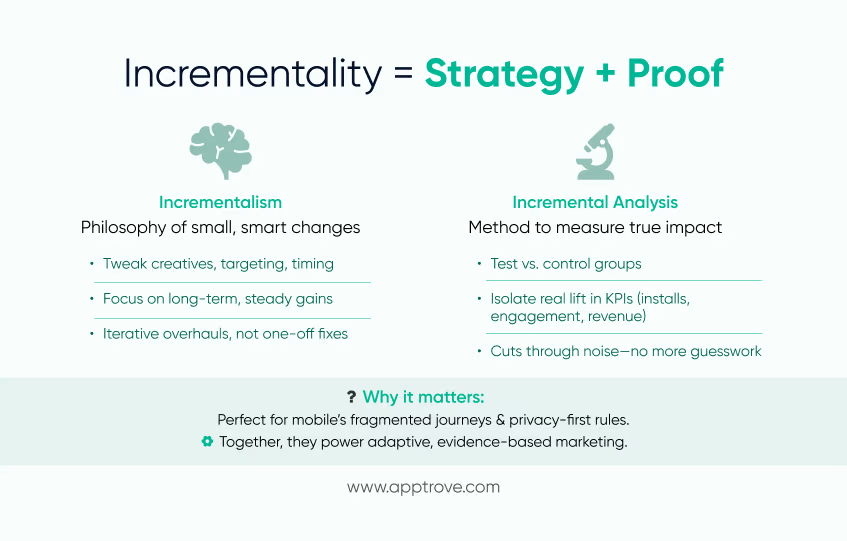
Incrementalism: The Philosophy of Precision over Scale
An incrementalism-based strategic thinking rests on the vision that graduating changes through a progressive, deliberate steady process can make significant discoveries and lasting growth. It is often nicer to pursue systematic and iterative experiments all over the marketing funnel due to incrementalism than to pursue macro changes of overhauling or quick fixes transformations.
This strategy promotes marketers to:
- Tweak minor excursions on creative messaging, tone or format
- Make changes with clear hypotheses in regulations on bidding or placements
- Adjust audience dividing standards (demographics, behaviors, affinities)
- Adjust the timing, capping frequency or schedule of campaign
The aim is not quick ramp up, but quantifiable improvement, which is evidence-based. Incrementalism acknowledges that there is no single optimization in the modern fragmented and noisy ad space, but optimization is an on-going discipline. Maintained regularly, it gives teams a means to create an adaptive marketing machine that not only works but gets better and better over time, not merely in spurts.
Notably, incrementalism does not necessitate large budgets and extended periods. The strength is that even the micro-experiments have the ability to reveal important performance levers, particularly when the behavior of the users is rapidly changing due to new platforms, devices, or on macro-economic changes.
Incremental Analysis: The Science Behind the Strategy
If incrementalism is the philosophy, then incremental analysis is the methodology that brings it to life. It entails confirming whether a determined action in marketing with regard to displaying a specified advertisement or conducting a retargeting campaign had any causal influence on the behavior of its users.
The core of incremental analysis is rooted in experimental design. This typically entails the separation of a target audience into at least two categories:
- A non treatment group that receives the marketing treatment
- An open collective which does
Using the exposed group as the only way of achieving net differences in outcomes, i.e., conversions, revenue, engagement or retention, marketers can isolate the control. This difference is known as the incremental lift, and it represents the true impact of the marketing intervention.
What makes incremental analysis so powerful — and necessary — is that it eliminates confounding variables. It removes noise of any other campaigns, organic trends, seasonality, or user purpose. The end outcome is an unambiguous, unbiased quantitation of causality, rather than correlation.
Why This Matters in Mobile and Privacy-First Ecosystems
In mobile marketing in particular, with its nonlinear and highly fragmented user journeys in apps, devices and platforms, testing rigor of this nature is not optional, it is mission-critical. Throw in ever more complex limitations on user tracking (courtesy of such laws as GDPR and platforms like Apple ATT and SKAN) and traditional deterministic attribution is shot relatively soon.
Incremental analysis offers a privacy-compliant, scalable solution. It does not use a personal identifiers or deterministic tracking. Rather, it is based on observing behavior, randomization, and measure of outcomes at the aggregate level only and as such is individually suited to the contemporary ecosystem in which access to fine-grained user data is increasingly becoming restricted.
Moreover, this method does not limit to the performance marketing. It applies as well as in:
- Brand lift studies (Does a campaign change perception?)
- Product experiments (Do new features drive engagement?)
- Pricing tests (Does a discount strategy influence purchase velocity?)
The unifying thread is simple: if a marketing or product decision has an expected impact, incremental analysis is how you prove whether that impact actually occurred.
From Optimization to Transformation
When incrementalism and incremental analysis work in tandem, they empower marketing teams to move beyond guesswork and gut instinct. They actually facilitate systematic exploration, motivate evidence-based iteration, and above all steer marketing investments into activities that show ascertainable effects.
The era of information overload and limited visibility coupled with mounting demands of accountability is one that demands this exotic commodity of clarity provided by this marriage.
Where Incrementality Fits in Your Mobile Marketing Strategy
Incrementality is not a feature of your analytics stack. It is a philosophy at heart – a criterion in which everything should be seen in terms of marketing. Unlike attribution, which attempts to assign credit retroactively, incrementality is proactive. The question would be: Was it your marketing act which changed the behavior of the users or was it just something that appeared on the way?
This is not a question that concerns the performance ads or bottom-of-funnel strategies. The beauty of incrementality lies in its adaptability across the entire marketing funnel. From user acquisition to creative testing, from brand awareness to lifecycle re-engagement, incrementality introduces a level of accountability and evidence that traditional models simply cannot provide.
Let’s examine how incrementality can, and should, be embedded at every strategic layer of your mobile marketing operation.
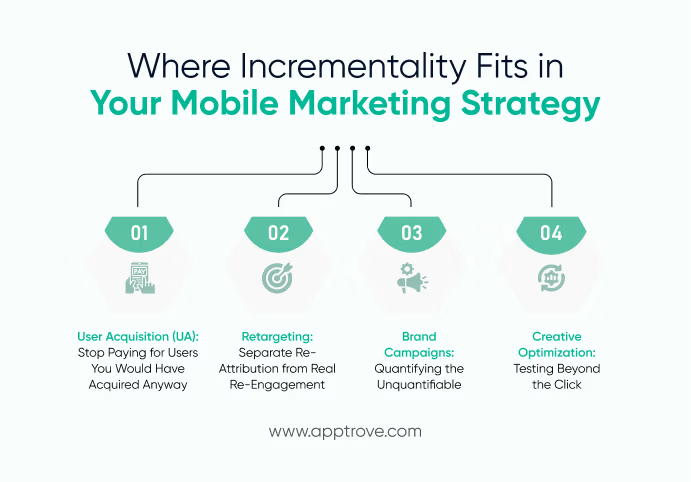
1. User Acquisition (UA): Stop Paying for Users You Would Have Acquired Anyway
The user acquisition is usually the biggest single expense on a cell phone marketer budget. Yet without incrementality, most UA strategies are built on shaky foundations. Attribution models, at least models of last-touch logic, will in nearly all circumstances demonstrate performance. The important question is however; is that performance additive?
Incrementality reframes UA success from volume-driven to impact-driven. It makes you question rather than cheering raw install figures:
- What is the number of these so-called net-new installs?
- What would be the case of these users downloading the app with or without paid media?
- Is this lifting intent, or just closing the deal?
You can control the incremental install rate by creating holdout groups (regions or audiences who do not see your ads), and by determining your true cost per incremental install (iCPI) you can often find that it is significantly higher than typical CPI reported by attribution tools.
Here the efficiency of the budget can be lost or gained. It is possible that campaigns which look like they are performing well, are in fact unnecessary.
2. Retargeting: Separate Re-Attribution from Real Re-Engagement
Retargeting is often miscomprehended to be a sure value-add. But then, when a dormant (or churned user) comes back after viewing an advertisement then is that not an indication that the ad worked?
Not necessarily.
Such users are already brand familiar. There are several who come back naturally; a person returns to see a particular order, discover some new material or due to habit. Retargeting providers, however, will automatically take credit on such returns, particularly in a post-view or impressions –based credit model.
Incrementality exposes this false attribution loop. When you divide your dormant audience into exposed and control categories you will be able to directly measure:
- How many returning users actually needed the retargeting nudge
- What percentage of conversions were truly caused by the ad
- Whether retargeting is cannibalizing organic reactivation
Recent conversion lift analysis suggests that around 60%of retargeting ad converted conversions were not actually incremental as the 40% of conversion lift only represents net‑new impact. This artificial drop of CAC and inflations of ROAS artificially reduce the CAC and inflate ROAS by marking the success of activity that would simply have occurred by itself.
With incrementality, retargeting is no longer a default. It then can be a testable hypothesis.
3. Brand Campaigns: Quantifying the Unquantifiable
Brand marketing historically has had an issue with measurement. It is incidental, not immediate and in many situations hard to relate to person activity, particularly in cell, where ID-level tracking has moved toward curtailed.
That does not imply that brand campaigns cannot be evaluated. All it translates to is that you measure them differently.
Incrementality introduces rigor to brand measurement through methodologies like:
- Geo-lift testing: Conduct a brand test in specific geographic areas, and withhold others to serve as control.
- Time-based testing: Compare some important performance metrics during a campaign flight, before and after.
- Proxy KPIs: Track the brand serached volume, social engagement, direct traffic (or within an app – the behavior).
Instead of guessing whether your TV spot or YouTube brand video is “doing something,” incrementality gives you causal proof. You will understand whether there were any measurable increases in downstream outcomes, downstream upticks, whether they are count based, whether they are installs or trials or purchase or behavioral signals of intent.
This converts brand marketing, a nebulous category of expenditure to a business impact meas surable driver.
4. Creative Optimization: Testing Beyond the Click
Marketers tend to switch creatives up over relatively superficial indicators such as CTR, engagement rate or thumb-stopping impression. However, such superficial metrics do not relay the entire picture.
An ad with a high CTR may cause one to stop and notice, but no meaningful action? Does it lead to users who keep your app, buy your app or refers your app? Or are you just going to maximize clickbait? Incrementality allows you to test creatives through the lens of impact, not just interaction.
Here’s how:
- Divide your audience into three categories: one deploys Creative A, one deploys Creative B and another is a control group that does not see an ad.
- Follow-up down the conversion funnel (e.g., installs, purchases, retention) on all populations.
- Calculate the incremental lift generated by each creative relative to the control.
No longer are you comparing which ad is receiving more clicks, you are now measuring which creative is actually causing net-new behavior. The innovation on the next level of insight turns the arduous process of the creative testing into an informed model of decision-making.
Incrementality as a Strategic Layer, Not a Tactical Add-On
When applied across these pillars; UA, retargeting, brand, and creative, incrementality shifts from being a campaign-specific testing tool to a strategic operating model.
It generates an accountability society of measurability throughout the widest part of the marketing entity. It boosts the prestige of experiment. And it makes your budget aligned with the actual business results rather than the mere surface performance indicators.
In a mobile marketing environment defined by volatility, privacy restrictions, and cross-channel complexity, incrementality is no longer optional. It is the sole means of drawing the line between pretty marketing and effective marketing.
Incrementality in Action: Use Cases That Separate Illusion from Impact
Understanding incrementality as a concept is critical. However, to make it actionable, it is important to see how it is applied in the real-life situations. The true power of incrementality testing lies in how it brings hidden insights to the surface, exposing inflated metrics, validating spend efficiency, and changing how marketing decisions are made across acquisition, retention, and branding efforts.
Let’s walk through a high-impact example that illustrate how incrementality reveals what attribution alone cannot.
User Acquisition: The High Cost of Illusion
Scenario: You run a user acquisition (UA) campaign in the state of California but hold back ads in another, demographically and behaviorally comparable state, Oregon. Both regions share similar app usage patterns, device distribution, and socioeconomic profiles, making them ideal for a geo-split incrementality test.
Two-week results:
- California (exposed to ads): 30, 000 app installs
- Oregon (control group): 27,500 app installs
This looks good at a glance: 30 000 installs and a budget of 100, 000 dollars equals a cost per install (CPI) of 3.33 dollars. Such velocity is however, not based on causality but only attribution.
Now let’s assess incremental lift:
- The installs difference between test and control = 2,500
- Actual incremental CPI= 100,000/ (2,500) =40.00
That is more than 10-fold the CPI reported by attribution platforms. That is to say that 27,500 of the 30000 installs would have occurred regardless of media spend.
The given example points to one of the most important factoids that volume without lift is noise. Without incrementality testing, you might have doubled down on a campaign that created little to no real growth, simply because attribution credited performance that wasn’t earned.
Retargeting: Re-Engagement or Re-Attribution?
Context: You are operating a retargeting campaign to focus on the dormant popu9la9ons who have not used your app within the previous 30 days. You divide the listeners into 2 equal length cohorts:
- Exposed group: Gets retargeting adverts
- Control group: Gets nothing
Following a period of 7 days campaign:
- Return rate (both groups): 15 per cent
After aggressive retargeting, the rate of returns is exactly the same in exposed and control group. The incremental lift is zero. This implies that your ad campaign did not make a causal contribution to re-engagement- all conversions would have occurred without the ad.
However, when only using this attribution data your DSP would also report thousands of re-attributed conversions so it would appear to be working. That is why the retargeting spend can turn into a black hole, money which is spent to claim credit of behavior which was already predetermined.
Incrementality testing reveals that without actual behavioral change, your campaign is not creating value, it’s just siphoning credit from organic user intent.
Key Takeaway: Attribution Shows Activity. Incrementality Shows Effectiveness.
Attribution in any of these setups would have spelled success in itself. Installs and returns were good on paper, as was engagement. But only incrementality revealed the truth behind the numbers:
- What portion of the performance was genuinely influenced by marketing?
- Where is your spend actually generating return?
- Which efforts are being over-credited, and which are quietly driving real growth?
In today’s increasingly complex mobile landscape, where user journeys are non-linear, attribution paths are fragmented, and privacy regulations obscure direct tracking, incrementality provides the clarity and confidence required to make intelligent, evidence-based decisions. It does not simply recount what the situation is. It gives you what was important.
The Wasted Spend Dilemma
Without incrementality, you’re pouring money into channels that look good, but aren’t moving the needle.
Let’s say:
- Facebook shows 50,000 installs with a $4 CPI
- Incrementality testing shows only 15,000 were incremental
- Your true CPI is $13.33
You thought the campaign was efficient, but your real cost of growth was over 3x higher than reported. That misalignment can make or break marketing ROI.
What Incrementality Adds That Attribution Can’t
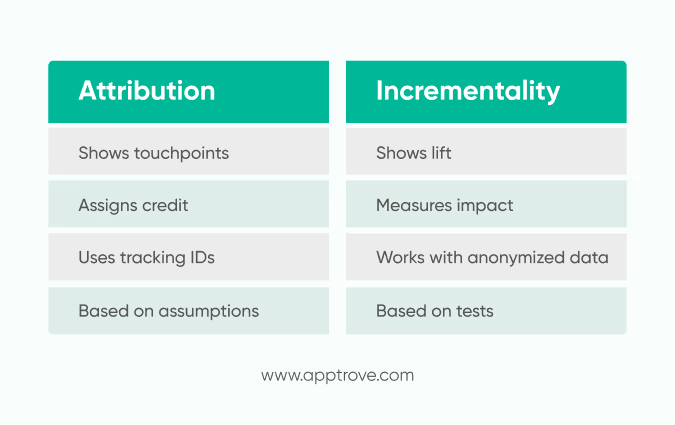
Incrementality doesn’t replace attribution. It complements it and gives your data meaning.
Why Most Marketers Misjudge Performance
Nearly 61% of marketers rely on conversion rates, and over 57% report ROI as primary success metrics, yet only 39% actually measure whether their work drives real business outcomes. This isn’t just a reporting issue, it’s a strategic failure.
On million-dollar budget lines you are not basing it on what cause and effect evidence but which is guesswork. This is an analogy of investing in stocks with the sole aim of following the previous price behaviour, without knowing what is behind the company.
Layering Attribution + Incrementality: The Modern Measurement Stack
In an ideal universe, marketing would yield to perfect measurement–all dollars followed, all contact points marked, all choice made with the unimpeachable certainty of deterministic accuracy. However, that is not our world. We live in a cluttered, disconnected, and growing privacy first world where no one measurement model can offer the complete scale of the world.
That’s why the most effective marketers don’t treat attribution and incrementality as competing philosophies — they treat them as complementary components of a modern, adaptive measurement stack.
Attribution Tells You Where. Incrementality Tells You Why.
Attribution Last-touch, multi-touch or data-driven is useful with respect to user journeys. It assists in trace the route to conversion and shows which platforms, campaigns and creatives among the ones deployed actually had a visible effect of getting someone through the door from being aware to taking an action. It is particularly handy when it comes to channel planning, funnel diagnostics, and the real-time optimization.
Attribution however makes one severe assumption, which is the fact that participation is equivalent to contribution. It gives credit to all touchpoints that happened on the way, irrespective of the presence of any causal involvement.
This is where incrementality enters as the missing half of the equation.
Incrementality doesn’t ask who was present — it asks who made a difference. It removes coincidence, correlation and proximity based biases. It separates what actually worked and what just rode piggyback by separating any ad exposure/ click that didn t work.
By layering attribution and incrementality together, marketers gain access to both dimensions of insight:
- Attribution = Visibility (What did the user see?)
- Incrementality = Validity (Did those experiences matter?)
The Power of a Dual-Model Approach
Consider how these two methods work in tandem:
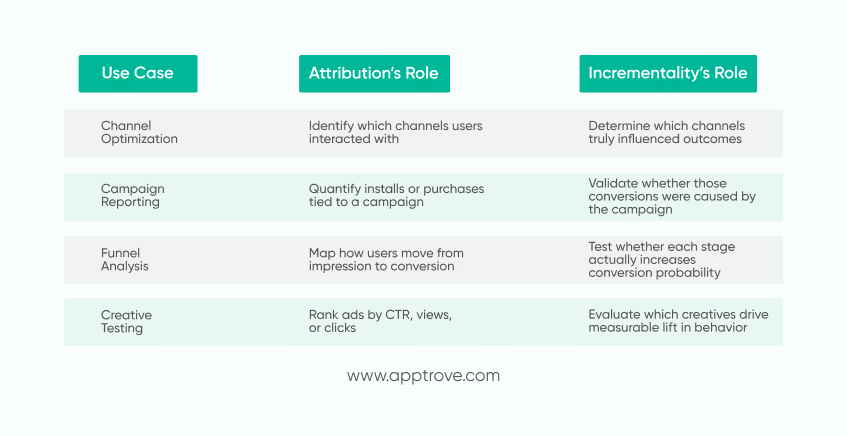
This dual-model approach equips you to move faster and think smarter:
- Use attribution for tactical decision-making and day-to-day optimization.
- Use incrementality for strategic investment and long-term accountability.
Attribution helps you steer. Incrementality ensures you’re not sailing in circles.
Implementing the Stack: Practical Advice
These are some of the main steps to follow when developing or developing your measurement stack:
- Keep a strong attribution infrastructure in place, but do not use it as a source of truth. Take it as a layer of visibility.
- Design ongoing incrementality tests; using holdouts, geo-splits, and audience randomization to isolate true performance.
- Integrate both data sets into your dashboards, reporting and analysis pipelines. Being seen without having credibility is dangerous.
- Educate your teams and the leadership that not all attributed performance is an incremental performance.
- Where possible, automate with platform (such as Apptrove or your internal BI) lift measurement and attribution information on a mass scale.
A Better Framework for a Complex World
The fact is: neither model is an ideal one per se. Attribution is simplistic in cause. Incrementality can’t map journeys. However, combined, they offer a multi-dimensional perception of marketing performance, which is much stronger, valid, and practical compared to either model individually.
When the user journeys live across dozens of platforms so nothing is visible (even with permission), when marketing dollars are getting more pressure (and when privacy laws are limiting visibility even further), then this layered approach is no longer just best practice, it is simply survival.
Privacy, SKAN, and the Death of Determinism
Mobile marketers have been enjoying a hyper-granular, user level data environment over years. Attribution was deterministic, real-time and precise with the help of Identifier for Advertisers (IDFA) that served as a universal key. You might track a user in-app, device and touchpoints and attribute each ad impression, click to install to a known identity. Marketing was scientific, controllable and scalable.
Until iOS 14.5, that is, and App Tracking Transparency (ATT) with it.
Apple killed the backbone of deterministic mobile attribution as part of one of its key policy changes. The IDFA became unavailable in most of the app sessions without user permission to be tracked. This was followed by the development of SKAdNetwork (SKAN), an Apple privacy-conscious mobile measurement system which introduced:
- Postbacks that are timer-based and delay signals of conversion
- No access to data on a user basis
- Short windows of attribution and granularity of conversions
- No visibility on real-time basis
- Knowledge-Poisoned campaign metadata
In this new world, there is no longer such thing as certainty. Most performance marketing analytics is traditionally based on deterministic attribution, but, as it can now be seen, it does not operate as it did in the past.
Welcome to the Era of Low-Signal Measurement
SKAN is not a systems bug. It is an attribute that strives to answer the emerging privacy appeal. It however drags another serious challenge of how then do you gauge the same impact now that you can no longer trace the user?
This is where incrementality steps forward, not as a patch or workaround, but as the natural evolution of measurement strategy in a privacy-first world.
Why Incrementality Thrives Where Attribution Fails
Incrementality does not require user-level tracking. It is independent of device IDs, click chains, and fingerprint methods (also heavily being phased out). Rather, it depends on experimental design and the comparative measure and thus it is immune to signal loss.
Here’s why incrementality is uniquely suited for modern, privacy-compliant marketing:
1. It Operates Without Tracing of Individual Users
Incrementality is based on observed outcomes at the cohort or geo level, not on deterministic identity resolution. Regardless of whether you are conducting a holdout test between countries, DMA areas, or anonymized user groups you do not need to know who has converted just that behavior has changed when comparing segments.
2. It Supports Multiple Methodologies
You can run incrementality tests using:
- Geo-split testing (e.g., campaign in City A, withheld in City B)
- Audience holdouts (e.g., 90% exposed, 10% control)
- Media mix modeling (MMM) – combining spend data, impressions, and macro KPIs across channels to assess contribution
The techniques are resistant, scaleable, and in accordance with the most restrictive privacy rules.
3. It Lives Off of Anonymized Data in Bulk Form
In contrast to attribution models that falter when granular data is lost, incrementality can flourish with aggregated performance indicators. You are not attaching individual behavior, you are attaching group level lift which tends to be more predictable on a strategic planning and a long-term investment perspective.
The Strategic Shift: From Tracking to Testing
Marketing teams need to undergo a mindset shift. In a deterministic world, you measured everything because you could. But in a probabilistic, privacy-bound world, measurement is no longer about tracking — it’s about testing.
Instead of asking: “Where did this user come from?”
You should be asking: “What would have happened if we didn’t show this ad to this segment?”
This question demands experimentation, not attribution logs. And it demands statistical validation, not sequence-based assumption.
Incrementality Is Future-Proof. Attribution Is Not.
As privacy regulations tighten (GDPR, CCPA, CPRA) and as platforms like Apple and Google remove access to identifiers, the reality is clear: deterministic, user-level attribution is living on borrowed time.
Incrementality offers a sustainable alternative. It’s:
- Platform-agnostic
- Privacy-compliant
- Causally accurate
- Statistically rigorous
- Strategically essential
It shifts the center of gravity from user tracking to behavioral understanding, empowering marketers to operate effectively even when identifiers, real-time data, or conversion chains are no longer available.
In short, if attribution was the compass for performance marketing in the 2010s, incrementality is the navigational system for the privacy-first era.
Shorter Attribution Windows: A Smarter Default for a Faster, Privacy-First World
Thirty-day attribution windows were the industry standard years ago a default that is a remnant of the first days of digital advertising when we move more slowly and with less devices daily and, privacy issues still do not exist. Marketers were hoping to have a long windows to see that they could attribute the conversion in a long term scale and to ascribe a value to early stage touch points in their funnel and gain as much attribution of credit as possible on any campaign.
However, that reasoning is not applicable anymore today. The present mobile user has a totally different pace. Much of the interaction occurs at minutes or hours as opposed to days and weeks in terms of app installs, purchases, and sign-ups. Not only have these attacks created shorter attention spans, but conversion windows as well, with the explosion of real-time consumption of content, instantaneous gratification UX and on-demand decision-making.
Meanwhile, new and emerging privacy regulations, such as Apple AppTrackingTransparency (ATT), Google Privacy Sandbox and legislation in place outside the US, such as GDPR and CPRA, are limiting the tracking window by design. SKAdNetwork postbacks are delayed and anonymous, the server side logs are cut short, and cookie persistence has become more ephemeral. 30-day attribution windows are not precise anymore in a new context- they are deceitful.
Why Long Attribution Windows No Longer Serve You
In cases where there is excess length of attribution windows:
- They overstate performance indicators by recording organic or delayed conversions which have nothing to do with your campaigns.
- They give credit to touchpoints that came weeks prior to a user making a decision, and invalidate any mention of causal effect.
- They also breach some new data compliance requirements, which will tend to curtail the length of time data is safeguarded or its processing.
- And what is most bad about it that they mask the real marketing efficiency, making your team get a misrepresented picture of the ROAS, CAC, and the influence of channels.
The Case for 7-Day and 3-Day Windows
Conversely, shorter attribution windows such as 7 days (sometimes 3) have a number of major benefits:
More Accurate
The smaller windows put less emphasis on attribution and more on the real behaviour of the user. Most conversions on rapid-cycle verticals such as gaming, fintech, food delivery, or ecommerce occur in hours or days after viewing an ad. The longer windows will cause noise and false positives.
More Compliant
Regulatory frameworks that have expanded on limited terms regarding data storage and user tracking lead to a reduced need to spend more time, thus legal risk minimization and bracing ahead in regard to legal compliance by the brands.
Less Inflated
The act of trimming attribution windows eliminates puff on your performance metrics. It removes conversions that would have happened regardless of the campaign thus giving a cleaner and truer view of effective marketing.
Pairing Short Windows with Incrementality: The Precision + Truth Model
A shorter attribution window alone isn’t a silver bullet, but when combined with incrementality testing, it becomes part of a powerful measurement framework.
- Short windows in attribution provide you accurate timing and directional clarity or vision
- Incrementality validates causal impact by isolating lift
- They all bring both clarity and truth together.
The two-in-one approach enables the marketing departments to:
- Prevent duplication or wrong attribution
- Be quicker responding to the trends of performance in the campaigns
- Show real value to the stakeholders in finance, products, and executives
Make informed media penetration decisions based on reality and not puffed up dashboards
A New Default for a New Era
Attribution windows should change in the realm of a marketing environment wherein activities are quicker and the regulations are tighter.
When you are still using 30 days or even 14 days window, you need to rethink the situation. It is longer windows, but strategically, it is not better to have shorter windows. They make your information fit into the current trend of user behavior, compliance requirements and corporate responsibility.
Shorter windows + incrementality = a measurement strategy built for the future.
Using Apptrove to Bring It All Together
Incrementality testing can be complex. Apptrove’s platform simplifies it by giving you:
- Real-time visibility into fee-to-lift correlation
- Side-by-side view of attributed vs. incremental installs
- Privacy-safe metrics like SKANNative Lift
- Unified dashboards for UA, retargeting, and creatives
No more flying blind. No more vanity ROAS. Just clean, causal clarity.
Conclusion
Incrementality is not just another metric in a sea of KPIs. It does not belong to tactics. And not at all a trend. It is a paradigm change in the perception of performance, accountability and truth by the marketers.
In an era where the marketing landscape is clouded by signal loss, fragmented attribution paths, increasing user privacy controls, and platform-imposed limitations, incrementality stands out as a strategic imperative. It is the antidote to vanity measures, the reprieve against budget inefficiency, and the most clear prism we have in seeing the difference between meaningless activity and the measurement of difference.
This is an essential challenge to Marketing teams today as most of the tools and dashboards they use present incomplete or misleading stories. Attribution gives credits liberally thus campaigns look successful. But underneath the numbers lies a deeper truth — one that only incrementality can surface:
Did your marketing actually cause change, or did it simply capture it?
This question is not just academic. It has direct implications for how you invest your budget, prioritize your channels, report to stakeholders, and scale what works.
With incrementality at the core of your measurement framework, you enable your team to:
- Move beyond correlation and optimize for causality
- Avoid inflated performance metrics that distort decision-making
- Allocate resources to the campaigns, creatives, and channels that drive real business growth
- Operate with confidence in environments where tracking is limited or user-level data is inaccessible
Perhaps most importantly, incrementality reframes your role as a marketer. Optimizing for dashboard-level metrics are a thing of the past, you are now having direct business impact as a result of your actions. You are formulating campaigns that work not only but that count.
The research method is tried and tested. The instruments, including holdout tests or geo experiments or platforms integrations such as Apptrove already exist. What is left is the change of mindset: change it to “Who earned the credit?” to the question, “What really influenced the result?”
That single shift is between good and great marketers. It isolates the noise and signal. And it dissociates improvident expenditure and prudent investment.
It seems simpler and simpler in a world that is increasingly complicated. Let incrementality be the compass that guides your team through uncertainty, complexity, and change.
Let it ground your reporting in evidence. Let it align your strategy with reality. Let it be, without question, the metric that actually matters! Apptrove lets you test attribution models side-by-side, so you can validate which model most closely mirrors your true incrementality.


